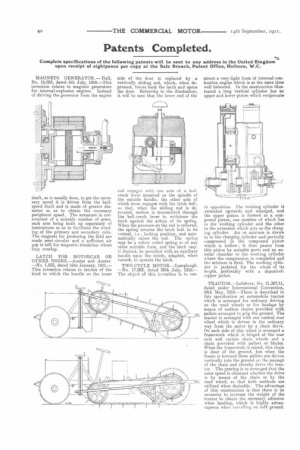Patents Completed.
Page 20

If you've noticed an error in this article please click here to report it so we can fix it.
Complete specifications of the following patents will be sent to any address in the United Kingdom upon receipt of eightpence per copy at the Sale Branch, Patent Office, Holborn, W.C.
MAGNETO GENERATOR.— Hall, No. 16,093, dated 6th July, 1910.—This invention relates to magneto generators for internal-explosion engines. Instead of driving the generator from the engine
shaft, as is usually done, to get the necessary speed it is driven from the halfspeed shaft and is made of greater diameter so as to obtain the necessary peripheral speed. The armature is constructed of a suitable number of arms, each arm being built up separately of laminations so as to facilitate the winding of the primary and secondary coils. The magnets for producing the field are made semi-circular and a sufficient air gap is left for magnetic insulation where they overlap.
LATCH FOR MOTORCAR OR OTHER DOORS.—Auster and Auster. —No. 1,093, dated 16th January, 1911.— This invention relates to latches of the kind in which the handle on the inner side of the door is replaced by a vertically sliding rod, which, when depressed, forces back the latch and opens the door. Referring to the illustration, it will be seen that the lower end of the rod engages with c.ne arm of a bellcrank lever mounted on the spindle of the outside handle, the other arm of which lever engages with the latch bolt, so that, when the sliding rod is depressed, motion is transmitted through the bell-crank lever to withdraw the latch against the action of its spring. When the pressure on the rod is relieved, the spring returns the latch bolt to its normal, i.e., lacking position, and auto matically raises the rod. The spring may be a volute coiled spring or of any other suitable form, and the latch may, if desired, be provided with an auxiliary handle upon the inside, adapted, when turned, to operate the latch.
TWO-CYCLE MOTOR.—Lamplough. —No. 17,983, dated 28th July, 1910.— The object of this invention is to con garnet a very-light form of internal-combustion engine which is at the same time well balanced. In the construction illustrated a long vertical cylinder has an upper and lower piston which reciprocate
in opposition. The working cylinder is extended upwards and enlarged, and the upper piston is formed as a compound piston, one member of which lies in the working cylinder and the other in the extension which acts as the charging cylinder. Air or mixture is drawn in to the charging cylinder and partially compressed in the compound piston which is hollow ; it then passes from this piston by suitable ports and an annular chamber to the working cylinder where the compression is completed and the mixture is fired. The working cylinder is jacketed for the whole of its length, preferably with a depositedcopper jacket.
TRACTOR.—Lefebvre, No. 11,307/11, dated under International Convention, 24th May, 1910.—There is described in this specification an automobile tractor which is arranged for ordinary driving on the road wheels or for haulage by means of endless chains provided with pallets arranged to grip the ground. The tractor is arranged with one central rear wheel which is driven in the ordinary way from the motor by a chain drive. On each side of this wheel is arranged a framework which is hinged at the rear axle and carries chain wheels and a chain provided with pallets or blades. When the framework is raised, this chain is clear of the ground, but when the frame is lowered these pallets are driven vertically into the ground on the passage of the chain and thereby drive the tractor. The gearing is so arranged that the same speed is obtained whether the drive is by means of the chain or by the road wheel, so that both methods are utilized when desirable. The advantage of this construction is that there is no necessity to increase the weight of the tractor to obtain the necessary adhesion when hauling, which is highly advantageous when travailing on soft ground.




















